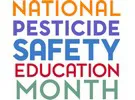 The second annual National Pesticide Safety Education Month gets underway February 1st, to reinforce core principles of safe handling and use and to raise awareness of and support for the land-grant university Pesticide Safety Education Programs (PSEPs). Pesticide safety is an absolute requirement when using the chemical component of Integrated Pest Management (IPM).
The second annual National Pesticide Safety Education Month gets underway February 1st, to reinforce core principles of safe handling and use and to raise awareness of and support for the land-grant university Pesticide Safety Education Programs (PSEPs). Pesticide safety is an absolute requirement when using the chemical component of Integrated Pest Management (IPM).
“IPM considers the variety of pest management methods and teaches how to properly manage pests, whether the approach contains chemicals or not,” says Cecil Tharp, Montana State University PSEP. “A vital role of PSEPs in teaching IPM is to pass along the message that it is not solely pesticides that should be used to deal with pests,” adds Jon Johnson, Penn State University PSEP.
“We take all the IPM strategies and do a lot of planning to prevent pests. If there is an unacceptable pest infestation at some point, pesticides may be required and their safe use is essential,” explains Lisa Blecker, University of California PSEP. “The IPM process has the key role in helping applicators understand all the available tools and make appropriate decisions to control the pest,” notes Clyde Ogg, University of Nebraska PSEP. “That includes being as smart as we can in the use of pesticides,” adds Gene Merkl, Mississippi State University PSEP.
“While PSEPs are often focused on teaching the safe use of pesticides, pesticides are only one possible choice in the IPM toolbox and not always the best choice,” says Mimi Rose, Ohio State University PSEP. “Even if the applicator chooses to use a pesticide, there are other pest management practices that must also be followed to successfully manage the pest.” Don Renchie, Texas A&M PSEP, summarizes the big picture – “When everyone understands the importance of IPM strategies and other best management practices, it avoids problems for the general public and the environment, and for pesticide applicators. With or without pesticides, protecting human health and the environment is always the goal.”
Visit the National Pesticide Safety Education Month webpage to review basic pesticide safety principles and much more. Everyone is invited to share the link with others and use the educational resources, self-assessment and quiz to promote safe use of pesticides, whenever pesticides are used.
Source: IPM in the South (Carol Somody)
